Advertisement
Challenging procedure minimizes newborn’s hypoxia risk
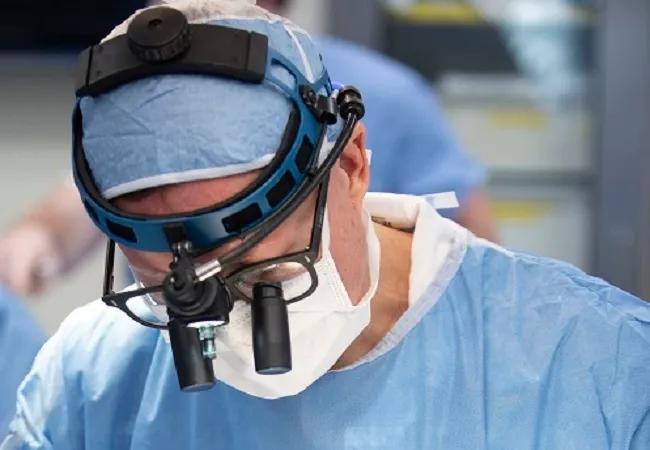
In a complex fetal surgery procedure performed at Cleveland Clinic, a multidisciplinary team led by pediatric and fetal surgeon Darrell Cass, MD, established an airway in a partially delivered fetus with a large trachea-obstructing neck mass, enabling a safe birth and subsequent removal of the tumor.
Advertisement
Cleveland Clinic is a non-profit academic medical center. Advertising on our site helps support our mission. We do not endorse non-Cleveland Clinic products or services. Policy
The two-hour operation, known as EXIT (ex-utero intrapartum treatment)-to-airway, took advantage of uteroplacental blood flow and maternal-fetal gas exchange while the fetus’ trachea was secured. Full delivery and ventilation followed.
The EXIT-to-airway approach minimizes the risk of life-threatening asphyxia or hypoxia at birth due to airway obstruction. The fetus in this case had a giant neck mass at the anterior aspect of the trachea that was compressing the trachea and esophagus, which would have required emergency airway interventions immediately after birth for the fetus to breathe. Instead, the airway was safely secured, allowing resection of the neck mass the day after delivery.
“EXIT-to-airway is a strategy to optimize the transition of a baby with airway obstruction from the fetal to the postnatal environment,” says Dr. Cass, who had successfully performed the surgery more than 50 times during his tenure as co-director of Texas Children’s Fetal Center. He joined Cleveland Clinic in 2017 to launch its fetal surgery program.
“Trying to intubate a baby with a large neck mass after a traditional delivery can be very complicated and hectic,” Dr. Cass says. It may take 20 minutes to achieve ventilation, resulting in anoxic brain damage and potential mortality. Taking advantage of placental support, “the EXIT-to-airway approach accomplishes intubation in a controlled fashion, when the fetus is stable and the setting is calm. In some instances a tracheostomy may be needed, and this can be accomplished safely using this fetal surgical approach.”
“The procedure went very, very well,” Dr. Cass says. Mother and child recovered without complications after the December, 2019, fetal surgery and neck mass resection and were discharged. The baby “is feeding by mouth and is completely normal. It couldn’t have been a better outcome.”
The EXIT strategy was devised by Dr. Cass’s mentor, University of California San Francisco pediatric surgeon and fetal surgery pioneer Michael Harrison, MD, in the late 1990s.
Its initial purpose was to help surgeons safely unblock fetal airways that had intentionally been obstructed in utero to treat congenital diaphragmatic hernia (CDH). The PLUG (Plug the Lung Until it Grows) technique, which Dr. Harrison had developed several years before EXIT, uses tracheal occlusion to obstruct the flow of lung fluid in fetuses with CDH, inducing pulmonary hyperplasia and pushing herniated viscera from the chest. But the PLUG method required a safe means of removing the tracheal block and establishing an airway at birth.
Advertisement
“So they invented the EXIT procedure to facilitate unclipping the trachea,” Dr. Cass says, “and then it became obvious that we should use this for other situations where the fetal airway is blocked,” or when compression from rapidly growing chest or lung masses poses cardiopulmonary harm.
That latter EXIT permutation involves removal of the lung mass while the partially delivered fetus remains on utero-placental “bypass” during the procedure. Dr. Cass coined the term EXIT-to-resection for that procedure and has published case experiences and outcomes that have helped determine its use.
The EXIT-to-airway approach is the initial step for fetuses with large neck masses. The later step is removal of the neck mass to unblock the trachea. Dr. Cass and colleagues have described their experience with EXIT-to-airway and management of fetuses with large neck masses, including helping to define indications for the procedure.
Planning for EXIT treatment depends on early detection of fetal anomalies.
In the present case, a routine prenatal ultrasound scan at 29 weeks of gestation identified an anterior neck mass. Upon referral to Cleveland Clinic, magnetic resonance imaging showed a thick-walled cystic lesion in the midline of the neck, compressing and deflecting the trachea dorsally against the spine. The mass also was compressing the fetus’ esophagus, disrupting swallowing and causing polyhydraminos. Echocardiography indicated normal heart function.
Dr. Cass suspected the mass was a teratoma rather than a lymphatic malformation. Teratomas arise from germ cells, which are midline structures, whereas lymphatic malformations tend to manifest on either side of the neck and displace the trachea laterally.
The size of the neck mass precluded vaginal delivery because of the prospect that the fetus would become lodged in the birth canal or that the tumor would tear and cause fatal hemorrhaging. A standard Caesarian section would require emergency intubation, with the attendant risk of extended hypoxia.
Advertisement
The EXIT-to-airway procedure was scheduled for gestational week 37-38, to provide maximum time for fetal lung maturation. The mother’s polyhydraminos was monitored during the interim.
Members of the multidisciplinary fetal surgery team — more than two dozen physicians and nurses specializing in pediatric surgery, maternal-fetal medicine, pediatric cardiology and pediatric anesthesiology and their collaborators in pediatric otolaryngology and neonatal intensive care — met prior to the surgery to discuss the case and each operative step, practice their roles and review how they would handle potential complications.
“Although I have a lot of prior experience with EXIT to airway, this was a new procedure for my current team,” Dr. Cass says. “We met as a team and talked through all aspects of the procedure. Two days before the surgery, we did a walk-through where we rehearsed the different steps. I think our execution benefited from the preparations.”
As the operation began, the mother received deep general anesthesia to achieve complete uterine relaxation. Uterine flaccidity is necessary to preserve uteroplacental blood flow, although it poses the risk of extensive hemorrhage in the event of placental abruption.
An adjacent operating room was maintained on standby, in case the EXIT procedure had to be aborted and emergency resuscitation of the fetus was required.
Maternal and fetal monitoring was initiated using an arterial catheter, ultrasonography and echocardiography. Dr. Cass performed a transverse laparotomy using the Pfannenstiel approach to exteriorize the uterus. Ultrasound was used to identify placental margins to guide the uterine incision, and to confirm that the fetus’ head was in the cephalic position.
Dr. Cass and Special Delivery Unit Medical Director Amanda Kalan, MD, placed full-thickness stay-sutures in the uterine wall, then performed a lower uterine segment hysterotomy. They initially used electrocautery to make entry, followed by uterine stapling to achieve hemostasis and to secure the amniotic membrane to the uterine muscle to prevent membrane separation.
Advertisement
The fetus’ head, neck and right arm were extracted from the uterus, the latter to accommodate pulse oximetry and insertion of an intravenous cannula for administration of fluid and medications. Rapid infusion of warmed Ringer lactate maintained amniotic volume. Pediatric cardiologist Francine Erenberg, MD, monitored the fetus’ heart function and was present in the event cardiac resuscitation was needed.
Pediatric otolaryngologist Samantha Anne, MD, Medical Director of Pediatric Ear and Hearing Disorders, and team used direct laryngoscopy and rigid bronchoscopy to slide an endotracheal tube past the obstructing mass into the trachea. Correct placement was confirmed by manual ventilation, auscultation and blood gas levels. The tube was secured with a suture in the fetus’ upper gum.
If that method of intubation had failed, the surgeons were prepared to use the Seldinger technique to feed a guide wire retrograde through the vocal cords to allow antegrade tracheal intubation or, as a last resort, to perform a tracheostomy.
With the airway established, Dr. Cass placed an umbilical venous catheter. Obstetric and pediatric anesthesiologists McCallum Hoyt, MD, MBA, and Tara Hata, MD, reduced maternal anesthesia and administered intravenous oxytocin to prevent uterine atony and initiate contractions, decreasing hemorrhage risk.
Then the fetus, a boy, was fully delivered, the umbilical cord was clamped and divided, and the neonate was placed in an incubator for transport to the neonatal intensive care unit. The mother’s hysterotomy and laparotomy incisions were sutured.
The following day, Dr. Cass performed a four-hour operation to remove the infant’s neck mass. He began with a laryngoscopic examination of the vocal cords, to determine if pressure from the mass had caused any nerve trauma that might affect vocalization. There was no evidence of weakness or loss of function.
Dr. Cass used a moderate skin incision in the infant’s neck to optimize cosmesis. Resection involved dissecting through the neck to separate the muscles covering the midline, exposing the mass and carefully separating it from surrounding structures while avoiding nerve damage. The mass was approximately 7 centimeters in diameter. “Though many commented on the large size of the mass, it was one of the smaller and easier ones I’ve dealt with,” Dr. Cass says.
Advertisement
Pathology confirmed that it was an immature teratoma.
Five days after the resection, the infant was returned to the operating room so that Dr. Cass could re-evaluate his vocal cords and check the airway status after extubation. “That was successful,” Dr. Cass says. “He recovered for a couple of days and began feeding by mouth. He went home at 13 days of life, which is ideal.
“Fetal neck masses can be a tricky problem,” Dr. Cass continues. “Our EXIT to airway approach was designed to try to optimize the outcome. Our fetal surgery team is relatively new; we have only been working together for the last year or so. But everything proceeded perfectly and mother and baby recovered as well as we could have hoped. That’s perhaps a testament to thorough preparations.”
Previous fetal surgeries at Cleveland Clinic have involved myelomeningocele repairs. Dr. Cass expects the program’s volume and diversity of cases will grow.
“I’m very pleased with the progress our program has made,” he says. “The complexity that we’ve been dealing with already is high. We’re going to do more and different types of procedures. We’re going to work to expand our program’s outreach beyond the local region, to our campuses in Florida and then to our international campuses. My goal is to become one of the world’s leading fetal care programs. I’m very excited about the future.”
Advertisement
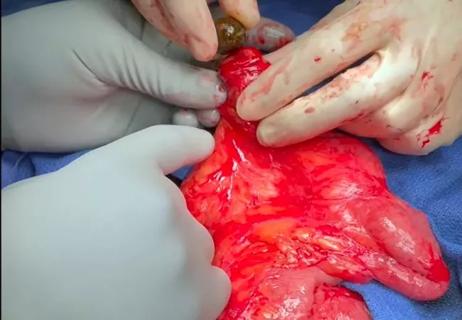
Technique is useful in patients with diffuse stricturing Crohn’s jejunoileitis

Lifesaving procedure, continued pregnancy and healthy delivery highlight program’s advancement
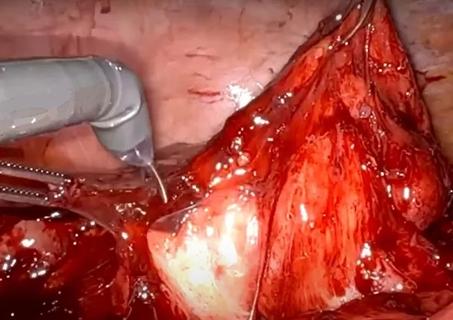
Robot-assisted technique provides an alternative to open surgery in a complex case
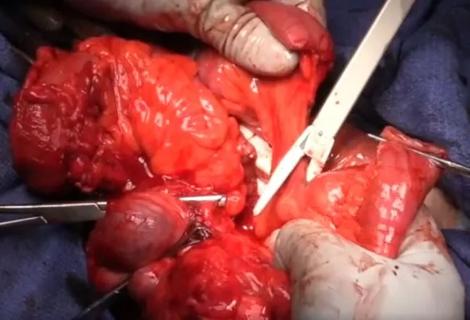
Cleveland Clinic team blends extended mesenteric excision and Kono-S anastomosis

Continued pregnancy and delivery are only the second successful outcome worldwide

FETO and twin-twin transfusion syndrome treatments are next
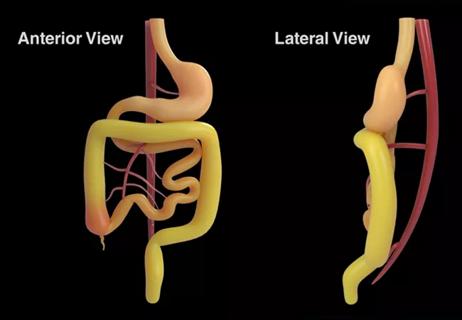
New procedure eliminates volvulus risk

Measuring outcomes becomes more granular with surgeon-entered data